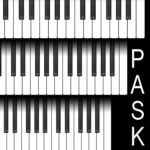Real world practicalities
The practicalities of having keyboards of different sizes in the ‘real world’ are far less than many people imagine.
The evidence, from those who have tried alternatively sized keyboards, shows that people almost always adapt to the smaller size remarkably quickly. They can also switch back and forth between sizes with little or no practice. See: Feedback from pianists. In this ideal ‘future’, most children will commence on a keyboard with narrower keys than today’s. Virtually all pianists will come across the alternative sizes during their youth and will be accustomed to playing them, so adult pianists will rarely need to ‘adapt’.
The higher the level of excellence a pianist reaches, the more important it is that the keyboard size suits the individual.
The persistence of the piano world to stick with one keyboard size starkly contrasts with the sporting world, where the need for equipment or clothing to suit the individual becomes most critical at elite levels. For example, a tiny advantage over the opposition can be gained by having a particular swimming costume or pair of track shoes, or the skis or tennis racquets with the latest technology. It is taken for granted that skis, tennis racquets or shoes must be exactly the right size for the individual.
For selection of FAQs and responses see: FAQs
The private home
There are a number of scenarios here:
· In a home where a young child is learning to play the piano but the adults to do not play, it would make sense for the family to invest in (or rent) a low cost digital or upright piano with a DS5.1® or DS5.5® keyboard. The family would only need to invest in a good quality upright or grand piano when the child has reached a relatively advanced level and has demonstrated a keenness to continue. At that stage, it would be clearer which size is going to be appropriate for the young person.
· Where more than one family member plays, there could be a range of solutions, such as having an upright in one size and a grand in another size, or having an acoustic piano along with a digital keyboard in a different size or having just one DS6.0® acoustic piano as the best compromise for all.
· A teenager entering tertiary piano studies may choose to do most of their practice at the university where there would be access to the keyboard size of their choice.
· In a household where one or more people play infrequently or play relatively simple pieces, the keyboard size won’t matter very much. Most males with average size hands have little trouble playing a DS5.5® or DS6.0® keyboard, just as most women currently ‘make do’ with the conventional (large) keyboard. If the father rarely plays, why should the rest of the family have to use the instrument that best suits him?
The teaching studio
In private teaching studios that cater for children and teenagers of different ages, it would make sense for teachers to have at least one stretto keyboard in a DS® size. Many teachers already have more than one piano available in their studios, so why not different sized keys? Teachers could publicise the sizes/types of pianos they have as a selling point, allowing parents to take this information into account when deciding on a teacher for their child. Two or more keyboards will mean that a teacher doesn’t need to restrict progress while waiting for a student’s hands to grow. Imagine a situation where instead of a student taking five years of study and hard practice to reach a particular level on a ‘large’ keyboard, they can reach the same level in half the time, while learning better technique, with the right sized keyboard.
Large manufacturers and retailers can have a major role in facilitating the ‘new world’ of alternative sizes for teachers and parents, such as expanding rental options and providing new pianos with DS® keys in concert and competition venues used by students, and in exam studios.
The widespread availability of ‘entry level’ pianos and keyboards is of paramount importance.
Schools and universities
If a university or school has six, sixteen or sixty pianos for students, it does not seem unreasonable for some of these to have narrower keys. A university or school offering different sized keyboards should have a significant marketing advantage over those that don’t. The cost of acquiring these keyboards could be outweighed by the revenue from increased student take-up.
Elite piano competitions and concert venues
At the world’s great performance halls and in elite national and international competitions, high quality concert grand pianos are a prerequisite. In this situation, it may not be necessary to have additional pianos, but instead make use of interchangeable keyboards for each grand piano. At around $US 15,000, the cost of an extra keyboard and action is insignificant compared to the outlay for a high quality grand, which might run to $100,000, or more.
Local piano competitions
Local piano competitions catering mainly for children and teenagers often make use of upright or small grand pianos rather than expensive concert grands. Over time, these venues could acquire an additional smaller size or both sizes (that is, DS6.0® and DS5.5®). As with private studios, not every competition would need to provide the three options. Publicity about a particular competition should mention the keyboard sizes available, allowing teachers and parents to select the best competition for their child or teenager. Major manufacturers and retailers would benefit by supplying alternative sizes. Another option could be for a piano with narrower keys to be rented or borrowed from another venue just for the competition. In the longer term, one would imagine that only the two smaller DS® sizes would be needed for competitions involving young people.


